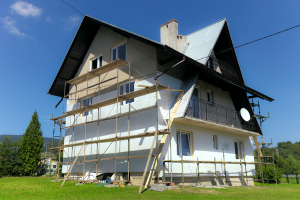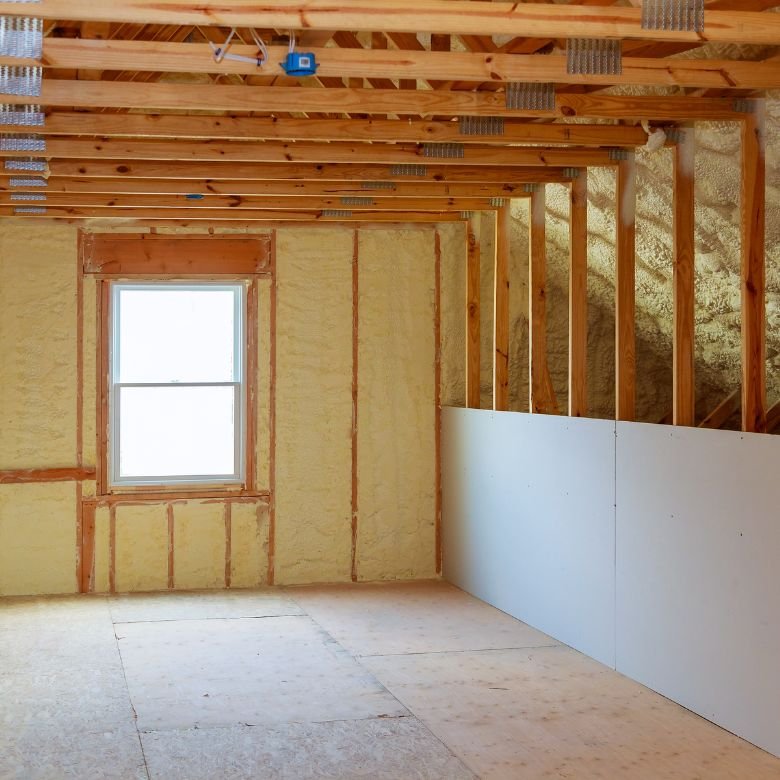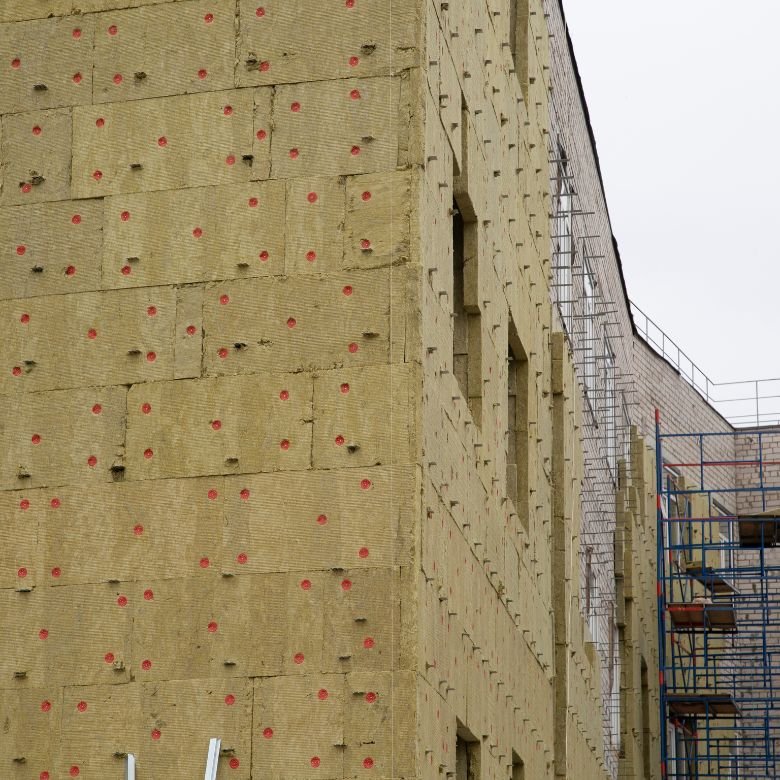Heat insulation materials in construction are not only those that we know the most: styrofoam and mineral wool. They also include such materials that provide better protection against heat loss and the permeation of cold air, while being thinner and resistant to moisture. Which materials will be best for insulating a roof, external walls, or foundations? Let’s find out!

Why do we use heat insulation materials in construction?
The layer of thermal insulation materials is applied above all to improve the building’s heat efficiency parameters. In practice, this means that such materials help us reduce heat loss and the penetration of cold air from the outside. Another application of thermal insulation materials in construction is sound insulation. With an additional layer installed at the wall or roof, the interior is better protected against noise.
Are thermal insulation materials always necessary? Yes, they are a commonly used standard. Concrete (the most popular material used for building walls and foundations) shows quite a high thermal conductivity coefficient (approx. 1–1.7 W/mK) and is susceptible to moisture. In consequence, non-insulated concrete elements poorly separate the interior from the outside and do not effectively keepthe warm air inside.
Read also about concrete additives and admixtures.
Find out what classes of concrete there are.
Using heat insulation materials in construction is not only a way to ensure thermal comfort at any time of the year. Insulation also helps building residents to reduce heating costs. Heating equipment can operate at a lower power and easier maintain the optimum inside temperature. This entails a lower energy consumption and lower costs.
What characteristics should be shown by thermal insulation materials used in buildings?
Building designers can choose between several types of thermal insulation materials, whether natural ones or those made of plastics. All those solutions have a few characteristics in common.
First and foremost, the heat insulation materials used in construction should meet the requirements set out in Polish Standard PN-EN 13172. Their thermal conductivity coefficient λ should not exceed 0.175 W/mᐧK. Good insulation materials are also such that:
- are moisture resistant: they absorb airborne water, rain and snow only to a small extent;
- are insensitive to temperature change: they should keep their properties both during frost and heat;
- do not get damaged by any forces or loads that act on them;
- are flexible and easy to install: their shape adapts to the wall or another building partition.

What materials are used to make building insulation?
The list of construction materials that can be used to make thermal insulation is quite long. The insulation of envelope components (elements located on the external side of a building) is nothing innovative. In the past, it used to be made of wood, sawdust, or even straw or peat. But those times are long gone; today such insulations occur only in structures built with traditional methods or in historic buildings subject to refurbishment supervised by a heritage conservation officer.
The contemporary heat insulation materials are much more effective in protecting against cold, less susceptible to moisture, easier to install, and safer (more resistant to fire, for example).
What heat insulation materials are most commonly used? The most popular ones include:
- Mineral wool – a product made of melted basalt rocks (rock wool) or quartz sand and cullet (so-called glass wool). It is available in the form of sheets or loose granulate. It serves as thermal and sound insulation. It is non-flammable, fireproof, and load resistant. However, it is also highly hygroscopic.
- Styrofoam – granules glued together to form panels of different thickness. Styrofoam is produced of processed expanded (EPS) and extruded (XPS) polystyrene. The thermal conductivity coefficient is 0.032 to 0.045 W/(m·K) for the EPS styrofoam and 0.021 to 0.03 W/(m·K) for extruded styrofoam. The latter is harder and shows very low susceptibility to moisture.
- Polyurethane, which has the form of a foam for spray insulation or the form of sandwich panels made of polyurethane foam. It presents very good thermal conductivity parameters, with the coefficient being only around 0.019–0.025 W/(m·K). Unlike mineral wool or styrofoam, it barely absorbs water. In consequence, it performs well also in locations exposed to moisture, for instance at the roof or close to wall gutters.
The best insulation materials for the roof, attic, external walls, or foundations
There is no universal heat insulation material being perfect for any environment. Depending on the place where the insulation is to be installed, different parameters can matter, such as vapour permeability, moisture resistance or load resistance. Which heat insulation materials will be the best for each envelope component?
Foundation insulation
When insulating lower parts of the building, the most important thing is to ensure that the material does not easily absorb water. Since foundations are located underground, they are constantly exposed to contact with moisture. Efficient thermal insulation for these elements in a building can be made of extruded styrofoam or polyurethane, whether in the form of panels or PUR foam.
Insulation of external walls
The requirements for the thermal conductivity coefficient U of walls are increasingly restrictive. To comply with them, building designers can choose between two solutions: either use a thicker material or select a solution that will provide the assumed parameters with a thinner insulation.
Thicker insulation layers are usually made of styrofoam panels (on double-layer walls) or mineral wool (on triple-layer walls). However, this technology has its flaws: the depth of window recesses grows along with the increasing thickness, which makes window installation more difficult.
This can be solved by applying a thinner insulation made of PIR panels. With a very low thermal conductivity coefficient, the panels can be thinner, which translates into lower consumption of materials and better access of light to the building interior.
Roof insulation
Pitched roofs are normally insulated with the use of mineral wool, which can fill the spaces between rafters very well. For flat roofs, it is best to use styrofoam or PIR panels. As the roof planes are difficult to access, they can be conveniently insulated with PUR foam.
In order to find high-quality insulation materials for various parts of your home, you should ask reputable manufacturers. The PCC Group is one of the leading suppliers of PUR foams, PIR panels and other construction materials. The full range of products can be found in the catalogue available on the Product Portal.

What can be the form of heat insulation materials?
Most of the popular heat insulation materials (wool, styrofoam) are available in the form of panels mounted to the surface of a building envelope component. The panels vary in thickness, so you can easily adjust the parameters of the insulation layer to your own needs. Styrofoam and mineral wool are also available in various sizes, and the panels can be cut to size.
For heat insulation materials made of polyurethane, the range is more extensive. Buildings can be insulated with the use of sandwich panels or foam that is applied on the surface of the envelope component with spray units. PIR heat insulation panels will be perfect for making an insulation layer at the entire wall or roof. Spray insulation made of PUR foam is worth using where local insulation is necessary, for example in the case of thermal bridges. This method of application allows to easily fill even small, hardly accessible cavities.
- https://www.energy.gov/energysaver/insulation-materials
- https://www.designingbuildings.co.uk/wiki/Thermal_insulation_for_buildings
- Abu-Jdayil, B., Mourad, A.-H., Hittini, W., Hassan, M., & Hameedi, S. (2019). Traditional, state-of-the-art and renewable thermal building insulation materials: An overview. Construction and Building Materials, 214, 709–735.
- https://www.izolacje.com.pl/artykul/sciany-stropy/222175,nowoczesne-materialy-termoizolacyjne-przykladowe-zastosowania-z-uwzglednieniem-wymagan-cieplno-wilgotnosciowych-od-1-stycznia-2021-r